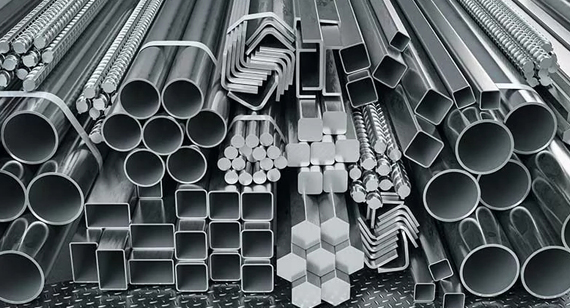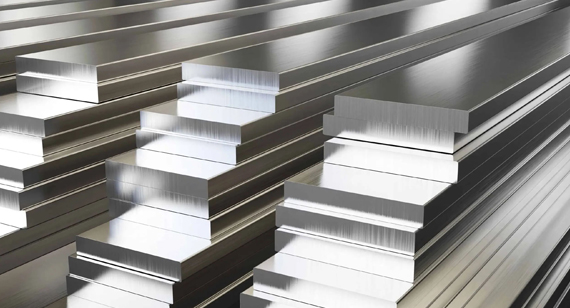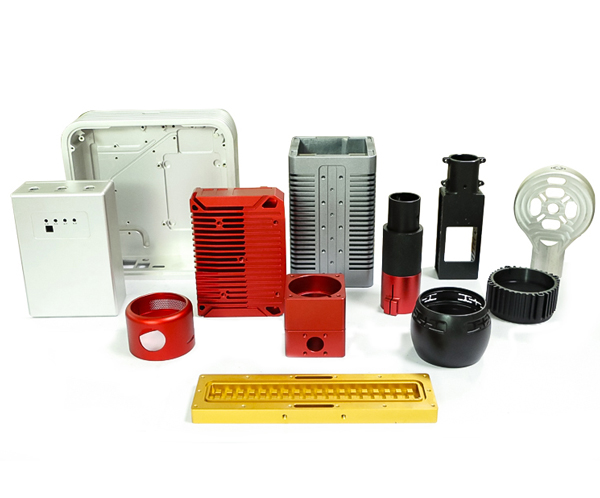15 years one-stop China custom CNC machining parts factory
 777 |
Published by VMT at Sep 07 2024
777 |
Published by VMT at Sep 07 2024
Aluminum alloys are among the most versatile materials in the manufacturing industry, offering a unique combination of light weight, strength, and corrosion resistance. These properties make them ideal for a wide range of applications, from aerospace to consumer goods. This article provides a comprehensive overview of aluminum alloys, exploring their types, characteristics, and applications. By understanding the different aluminum alloy types and their properties, manufacturers can select the most suitable material for precision CNC machining parts, ensuring optimal performance in their custom CNC machining projects.
An aluminum alloy is a material composed primarily of aluminum, combined with other elements such as copper, magnesium, silicon, zinc, and manganese. These additional elements enhance the physical and mechanical properties of aluminum, making it suitable for various industrial applications. Aluminum alloys are classified into different series based on their composition and the primary alloying element. Each series offers distinct characteristics, such as improved strength, corrosion resistance, or machinability, making them suitable for specific uses in industries like automotive, aerospace, and electronics.

Aluminum alloy grades are identified using a four-digit numerical system established by the Aluminum Association. The first digit indicates the major alloying element, while the remaining digits represent specific variations within that alloy series. For example, in the grade 6061, the "6" indicates that the alloy belongs to the 6xxx series, where magnesium and silicon are the primary alloying elements. The "061" identifies the specific alloy composition within this series. Understanding these grades is crucial for selecting the right aluminum alloy for a given application, especially in precision CNC machining, where material properties directly affect machining performance and final product quality.
Aluminum alloys are divided into different series based on their chemical composition and primary alloying elements. Each series offers unique properties that make them suitable for various applications:

1xxx Series (Pure Aluminum): The 1xxx series consists of pure aluminum, with a minimum of 99% aluminum content. These alloys are known for their excellent corrosion resistance, high electrical conductivity, and good workability. However, they have relatively low strength, limiting their use in structural applications. Common applications include electrical conductors, chemical processing equipment, and food packaging.
2xxx Series (Copper): The 2xxx series includes aluminum alloys with copper as the primary alloying element. These alloys offer high strength and excellent machinability but are less resistant to corrosion. They are often used in aerospace applications where strength is more critical than corrosion resistance. Examples include aircraft structures, automotive components, and high-performance engineering applications.
3xxx Series (Manganese): The 3xxx series contains manganese as the main alloying element, providing moderate strength and excellent corrosion resistance. These alloys are highly workable and are commonly used in applications that require good formability and resistance to corrosion, such as roofing, siding, and beverage cans.
4xxx Series (Silicon): The 4xxx series alloys include silicon as the primary alloying element, which lowers the melting point and improves fluidity during casting. These alloys are commonly used in welding and brazing applications, as well as in automotive components where a high degree of thermal stability is required.
5xxx Series (Magnesium): The 5xxx series alloys are known for their excellent corrosion resistance, high strength, and good weldability, thanks to the addition of magnesium. These alloys are widely used in marine applications, pressure vessels, and structural components in the automotive and aerospace industries.
6xxx Series (Magnesium and Silicon): The 6xxx series is one of the most versatile and widely used aluminum alloy series, combining the benefits of both magnesium and silicon. These alloys offer good strength, excellent corrosion resistance, and great machinability, making them ideal for CNC machining services. Common applications include structural components, pipelines, and architectural extrusions.
7xxx Series (Zinc): The 7xxx series alloys are some of the highest strength aluminum alloys available, with zinc as the primary alloying element. These alloys are commonly used in aerospace and defense applications, where high strength-to-weight ratios are crucial. They are also used in high-performance sporting equipment and automotive components.
Aluminum alloys are prized for their unique combination of physical and chemical properties, which make them suitable for a wide range of applications. Understanding these properties helps manufacturers choose the right alloy for their specific needs.
Physical Properties of Aluminum Alloys
Aluminum alloys exhibit several key physical properties that make them ideal for various industrial applications:
Density (g/cm³): Aluminum alloys have a low density, typically around 2.7 g/cm³, which makes them much lighter than steel or copper. This low density is one of the main reasons aluminum is widely used in aerospace and automotive industries, where weight reduction is crucial for performance and fuel efficiency.
Electrical Conductivity: Aluminum alloys have excellent electrical conductivity, making them ideal for electrical and electronic applications. While pure aluminum has the highest conductivity, alloying elements slightly reduce this property, but many aluminum alloys still maintain high conductivity, suitable for power transmission lines and electronic components.
Thermal Conductivity: Aluminum alloys also possess high thermal conductivity, which is essential in applications requiring efficient heat dissipation, such as heat exchangers, radiators, and electronic housings.
Coefficient of Thermal Expansion: Aluminum alloys have a relatively high coefficient of thermal expansion, which means they expand and contract with temperature changes. This property must be considered in applications where dimensional stability is critical, especially in precision CNC machining parts.
Specific Heat Capacity: Aluminum alloys have a specific heat capacity that allows them to absorb and retain heat, making them suitable for applications involving thermal cycling, such as cookware and heat sinks.
Table 1: Physical Properties of Aluminum Alloys
| Aluminum Alloy Type |
Density (g/cm³) |
Thermal Conductivity (W/mK) |
Electrical Conductivity (%IACS) |
Coefficient of Thermal Expansion (10^-6/K) |
Specific Heat Capacity (J/kg K |
| 1100 |
2.71 |
222 |
61.8 |
23.6 |
904 |
| 2024 |
2.78 |
121 |
49 |
23.2 |
875 |
| 3003 |
2.73 |
190 |
40 | 23.1 |
893 |
| 5052 |
2.68 |
105 |
35 | 23.8 |
880 |
| 6061 |
2.70 |
152 |
43 |
23.2 |
897 |
| 7075 |
2.81 |
130–150 |
37 | 23.6 |
714.8 |
Chemical Properties of Aluminum Alloys
The chemical properties of aluminum alloys further enhance their suitability for various applications:
Composition: The specific composition of aluminum alloys determines their strength, corrosion resistance, and workability. Alloying elements like copper, magnesium, silicon, and zinc are added to pure aluminum to tailor its properties for specific applications.
Corrosion Resistance: Aluminum alloys naturally form a protective oxide layer that prevents further oxidation and corrosion. This makes them ideal for outdoor and marine applications where exposure to moisture and harsh environments is common.
Lightweight: Aluminum alloys are known for their lightweight nature, which is crucial in industries like aerospace and automotive, where reducing weight without compromising strength is essential.
Weldability: Many aluminum alloys are easily welded, making them suitable for manufacturing complex structures. However, some alloys, particularly those in the 2xxx and 7xxx series, require special welding techniques due to their susceptibility to cracking.
Machinability: Aluminum alloys are generally easy to machine, especially the 6xxx series, which is widely used in CNC machining services. The machinability of an alloy depends on its composition, heat treatment, and the type of cutting tools used.
Anodizing Reaction: Anodizing is a process that enhances the natural oxide layer on aluminum alloys, improving corrosion resistance and allowing for various surface finishes. The 6xxx series, particularly 6061 aluminum, is known for its excellent anodizing characteristics, making it a popular choice for architectural and consumer applications.
Table 2: Chemical Properties of Aluminum Alloys
| Aluminum Alloy Type |
Composition |
Corrosion Resistance |
Weldability |
Machinability |
Anodizing Response |
| 1100 |
99.95% Al, 0.05–0.20% Cu, Iron: 0.95% max. |
Good |
Good |
Good |
Poor |
| 2024 |
93.50% Al, 4.3–4.5% Cu, 0.5–0.6% Mn, 1.3–1.5% Mg |
Poor |
Poor |
Good |
Poor |
| 3003 |
98.60% Al, 1.20% Mn, 0.12 Cu |
Good |
Good |
Good |
Poor |
| 5052 |
97.25% Al, 2.50% Mg, 0.25% Cr |
Good |
Good |
Poor |
Good |
| 6061 |
97.90% Al, 0.60% Si, 1.0% Mg, 0.2% Cr, 0.28% Cu |
Good |
Good |
Good |
Good |
| 7075 |
90.00% Al, 5.60% Zn, 2.50% Mg, 1.60% Cu |
Poor |
Poor |
Fair |
Good |
Aluminum alloys are used across a wide range of industries due to their versatility and unique properties:
Aerospace Industry: Aluminum alloys, particularly those in the 2xxx and 7xxx series, are extensively used in the aerospace industry for manufacturing aircraft structures, fuselages, and engine components. Their high strength-to-weight ratio and corrosion resistance make them ideal for aerospace applications.
Healthcare Industry: In the healthcare industry, aluminum alloys are used to manufacture medical devices, surgical instruments, and diagnostic equipment. Their lightweight, corrosion resistance, and ease of sterilization make them suitable for these critical applications.
Automotive Industry: The automotive industry relies on aluminum alloys, especially the 5xxx and 6xxx series, for manufacturing lightweight yet strong components such as engine blocks, transmission housings, and body panels. The use of aluminum alloys in vehicles contributes to improved fuel efficiency and reduced emissions.
Electrical and Electronic Engineering: Aluminum alloys are widely used in electrical and electronic engineering for producing components like heat sinks, power cables, and housings for electronic devices. Their excellent electrical and thermal conductivity, combined with lightweight properties, make them indispensable in this field.
Consumer Goods: Aluminum alloys are also prevalent in consumer goods, including cookware, sporting equipment, and household appliances. Their durability, lightweight, and resistance to corrosion make them ideal for everyday products.
Aluminum alloys offer several advantages that make them a preferred material in various industries:
Lightweight: Aluminum alloys are significantly lighter than steel, reducing the overall weight of products and structures. This is particularly important in industries like aerospace and automotive, where weight reduction leads to improved performance and fuel efficiency.
Corrosion Resistance: The natural oxide layer on aluminum alloys provides excellent corrosion resistance, making them suitable for outdoor and marine applications where exposure to moisture and harsh environments is common.
High Strength-to-Weight Ratio: Aluminum alloys offer a high strength-to-weight ratio, providing the necessary strength for structural applications without adding excessive weight.
Good Machinability: Many aluminum alloys, especially those in the 6xxx series, are easy to machine, making them ideal for CNC machining services. Their good machinability ensures high precision and efficiency in manufacturing processes.
Excellent Thermal and Electrical Conductivity: Aluminum alloys are known for their excellent thermal and electrical conductivity, making them suitable for applications requiring efficient heat dissipation and electrical conductivity.
Recyclability: Aluminum alloys are 100% recyclable without losing their properties, making them an environmentally friendly material choice.
Despite their many advantages, aluminum alloys also have some limitations:
Lower Strength Compared to Steel: While aluminum alloys offer a good strength-to-weight ratio, they generally have lower tensile strength compared to steel, limiting their use in applications where maximum strength is required.
Thermal Expansion: The high coefficient of thermal expansion in aluminum alloys can lead to dimensional changes in response to temperature fluctuations, which may affect precision in certain applications.
Cost: Some high-performance aluminum alloys, particularly those in the 7xxx series, can be more expensive than other materials, making them less suitable for cost-sensitive applications.
Weldability Issues: Certain aluminum alloys, especially in the 2xxx and 7xxx series, are prone to cracking during welding, requiring specialized techniques and equipment.
Susceptibility to Scratching and Denting: Aluminum alloys, especially those in the softer 1xxx and 3xxx series, are more susceptible to surface damage, which may require additional protective coatings or treatments.
Aluminum alloys can be classified into two broad categories: casting alloys and wrought alloys, each with distinct characteristics and applications.
Metal Alloy Elements: Casting alloys are designed to be cast into shapes, often using sand or die casting methods. They typically contain higher levels of silicon, which improves fluidity during casting. Wrought alloys, on the other hand, are intended to be mechanically worked into shapes through processes like rolling, forging, or extrusion.
Manufacturing Techniques: Casting alloys are melted and poured into molds, allowing for the creation of complex shapes and large components. Wrought alloys are mechanically processed, resulting in better mechanical properties and higher strength compared to casting alloys.
Characteristics: Casting alloys are generally less ductile but have good corrosion resistance and can be used to create intricate shapes. Wrought alloys are more ductile and have higher tensile strength, making them suitable for structural applications where mechanical properties are critical.

Several aluminum alloys are particularly well-suited for CNC machining due to their excellent machinability and desirable properties:
6061 Aluminum: Known for its good mechanical properties, corrosion resistance, and excellent machinability, 6061 aluminum is widely used in custom CNC machining for applications such as structural components, automotive parts, and aerospace components.
Aluminum 7075: This high-strength aluminum alloy is commonly used in aerospace and military applications. It offers superior strength-to-weight ratio and good fatigue resistance but is more challenging to machine compared to 6061.
Aluminum 5052: This alloy is known for its excellent corrosion resistance and good workability, making it suitable for marine and chemical applications. While it has lower strength than 6061, its superior corrosion resistance makes it a preferred choice for environments with high exposure to moisture.
Aluminum 6063: Often referred to as architectural aluminum, 6063 is known for its excellent surface finish and corrosion resistance, making it ideal for extrusion projects and structural applications in the construction industry.
When selecting the right aluminum alloy for a project, several factors must be considered:
Machinability Ratings: The machinability of an aluminum alloy affects the ease and speed of CNC machining. Alloys with higher machinability ratings, like 6061 and 6063, are preferred for precision CNC machining parts.
Material Cost and Availability: The cost and availability of the alloy can influence the choice, especially for large-scale production. While high-performance alloys like 7075 offer superior strength, they are also more expensive and may not be readily available.
Heat Treatment: Some aluminum alloys require heat treatment to achieve their full strength potential. Understanding the heat treatment requirements and how they affect machinability and final properties is crucial for making the right alloy choice.
At VMT, we specialize in precision CNC machining of aluminum alloys, offering custom CNC machining services to meet the unique needs of our clients. Whether you need high-strength components made from 7075 aluminum or corrosion-resistant parts from 5052 aluminum, our state-of-the-art CNC machining factory is equipped to deliver high-quality results. Our experienced team can assist you in selecting the right aluminum alloy for your project, ensuring optimal performance and efficiency.

Aluminum alloys are essential materials in modern manufacturing, offering a balance of lightweight properties, strength, corrosion resistance, and machinability. By understanding the different types of aluminum alloys and their characteristics, manufacturers can make informed decisions to enhance the performance and longevity of their products. Whether you’re working in aerospace, automotive, or consumer goods, selecting the right aluminum alloy is crucial for achieving the best results in CNC machining.

Do Aluminum Alloys Rust?
Aluminum alloys do not rust like steel because they form a protective oxide layer that prevents further oxidation. However, they can corrode under certain conditions, such as exposure to saltwater.
Which Aluminum Alloy is Better for Machinability, 6061 or 7075?
6061 aluminum is better for machinability, offering easier cutting and better surface finish, making it ideal for general-purpose machining. 7075, while stronger, is more challenging to machine.
How Many Types of Aluminum Alloys Are There?
Aluminum alloys are classified into several series based on their alloying elements, including 1xxx (pure aluminum), 2xxx (copper), 3xxx (manganese), 4xxx (silicon), 5xxx (magnesium), 6xxx (magnesium and silicon), and 7xxx (zinc).
What is the Difference Between 5052 and 6061 Aluminum?
5052 aluminum offers superior corrosion resistance and is more suited for marine applications, while 6061 aluminum provides better strength and machinability, making it more versatile for structural applications.
What is the Difference Between 6061 and 7075 Aluminum?
6061 aluminum is more versatile with good strength, machinability, and corrosion resistance, while 7075 aluminum offers higher strength and fatigue resistance, making it ideal for high-stress applications like aerospace components.
What Are Aluminum Alloys Made of?
Aluminum alloys are made of aluminum mixed with other elements such as copper, magnesium, silicon, zinc, and manganese to enhance their properties for specific applications.
What Are the Colors of Aluminum Alloys?
Aluminum alloys generally have a silver-gray color, but they can be anodized to achieve different colors and finishes for aesthetic or functional purposes.
What Kind of Metals Do Aluminum Alloys Belong to?
Aluminum alloys belong to the non-ferrous metal category, which means they do not contain iron and are resistant to rust and corrosion.
What Is the 5000 Series Aluminum Alloy?
The 5000 series aluminum alloys are primarily alloyed with magnesium, offering excellent corrosion resistance and moderate strength, making them ideal for marine and chemical applications.
What Is the Difference Between 4000 and 5000 Aluminum?
The 4000 series aluminum alloys are primarily alloyed with silicon, used mainly for welding and brazing applications, while the 5000 series are alloyed with magnesium, providing better corrosion resistance and weldability.
Which Aluminum Alloy Is Best?
The best aluminum alloy depends on the specific application requirements. For general use, 6061 aluminum is highly versatile, while 7075 is preferred for high-strength applications, and 5052 is ideal for corrosion-resistant applications.
This comprehensive guide to aluminum alloys provides a clear understanding of the different types, characteristics, and applications, helping you make informed decisions in your CNC machining projects. Whether you need lightweight, corrosion-resistant parts or high-strength components, aluminum alloys offer a solution tailored to your needs.
